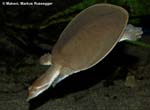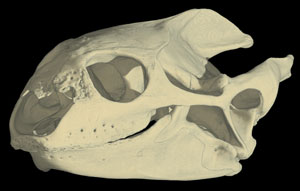Apalone mutica, the smooth softshell turtle, is a member of Trionychidae within Cryptodira. There are four extant species of Apalone (Ernst and Barbour, 1989; Bonin et al., 2006). Relationships among members of Trionychidae, and taxonomy within the clade, are still poorly understood (e.g., Meylan, 1987; Engstrom et al., 2004). Trionychidae has an extensive fossil record dating from the Cretaceous (Meylan, 1987). Long thought to be the sister-group to Kinosternidae (e.g., Gaffney, 1975; Gaffney and Meylan, 1988), the relationship of this taxon to other turtles has recently been called into question on the basis of both molecular and morphological features (e.g., Shafffer et al., 1997; Joyce, 2007).
Apalone mutica is distinguished  by its flat, smooth, skin-covered carapace that lacks horny scutes. The skull is elongate and distinctly emarginate, and a distinct tubular snout is present. Bones of the carapace are strongly pitted and the preneural is lacking (Ernst and Barbour, 1989). Members of Trionychidae, including A. mutica, exhibit a highly derived cranial arterial circulation that has implications for turtle phylogeny (e.g., Albrecht, 1967; Jamniczky and Russell, in press). The plastron is highly reduced and exhibits large callosities. The digits are webbed and long claws are present on the forelimbs of males and hindlimbs of females. Males may reach 18 cm, while females may reach 36 cm (Ernst and Barbour, 1989; Bonin et al., 2006). Apalone mutica is orange-brown to olive dorsally, with dark patches and often a lighter marginal band on the carapace, and white or gray ventrally. A light stripe with black borders extends through the eye to the neck (Ernst and Barbour, 1989; Bonin et al., 2006)
by its flat, smooth, skin-covered carapace that lacks horny scutes. The skull is elongate and distinctly emarginate, and a distinct tubular snout is present. Bones of the carapace are strongly pitted and the preneural is lacking (Ernst and Barbour, 1989). Members of Trionychidae, including A. mutica, exhibit a highly derived cranial arterial circulation that has implications for turtle phylogeny (e.g., Albrecht, 1967; Jamniczky and Russell, in press). The plastron is highly reduced and exhibits large callosities. The digits are webbed and long claws are present on the forelimbs of males and hindlimbs of females. Males may reach 18 cm, while females may reach 36 cm (Ernst and Barbour, 1989; Bonin et al., 2006). Apalone mutica is orange-brown to olive dorsally, with dark patches and often a lighter marginal band on the carapace, and white or gray ventrally. A light stripe with black borders extends through the eye to the neck (Ernst and Barbour, 1989; Bonin et al., 2006)
Apalone mutica is found in moderate- to fast-flowing fresh water, and occasionally in lakes and bogs, in the central United States from Ohio, Minnesota and South Dakota to Texas and New Mexico (Ernst and Barbour, 1989; Bonin et al., 2006). It is carnivorous and both an active and ambush predator of fish, amphibians, and aquatic invertebrates. Females lay two or three clutches per year, each consisting of three to 33 eggs (Ernst and Barbour, 1989; Bonin et al., 2006).

Literature
Albrecht P.W. 1967. The cranial arteries and cranial arterial foramina of the turtle genera Chrysemys, Sternotherus, and Trionyx: a comparative study with analysis of possible evolutionary implications. Tulane Studies in Zoology 14:81-99.
Bickham, J.W. and J.L. Carr. 1983. Taxonomy and phylogeny of the higher categories of cryptodiran turtles based on a cladistic analysis of chromosomal data. Copeia 1983:918-932.
Bonin, F., Devaux, B. and A. Dupré. 2006. Turtles of the World. Translated by P.C.H. Pritchard. Johns Hopkins University Press, Baltimore MD.
Engstrom, T.N., Shaffer, H.B. and W.P. McCord. 2004. Multiple data sets, high homoplasy, and the phylogeny of softshell turtles (Testudines: Trionychidae). Systematic Biology 53:693-710.
Ernst, C.H. and R.W. Barbour. 1989. Turtles of the World. Smithsonian Institution Press, Washington DC.
Ferri, V. 2002. Turtles and Tortoises. Firefly Books, Willowdale, ON.
Gaffney, E.S. 1972. An illustrated glossary of turtle skull nomenclature. American Museum Novitates 2486:1-33.
Gaffney, E.S. 1975. A phylogeny and classification of higher categories of turtles. Bulletin of the American Museum of Natural History 155:387-436.
Gaffney, E.S. 1979. Comparative cranial morphology of recent and fossil turtles. Bulletin of the American Museum of Natural History 164:1-376.
Gaffney, E.S. and P.A. Meylan. 1988. A phylogeny of turtles. In: Benton, M.J., editor. The Phylogeny and Classification of the Tetrapods, Volume 1: Amphibians, Reptiles, Birds. Clarendon Press, Oxford, pp. 157-219.
Jamniczky H.A. In press. Turtle carotid circulation: a character analysis case study. Biological Journal of the Linnean Society.
Jamniczky, H.A. and A.P. Russell. 2007. Reappraisal of patterns of nonmarine cryptodiran turtle carotid circulation: evidence from osteological correlates and soft tissues. Journal of Morphology 268:571-587.
Joyce, W.G. 2007. Phylogenetic relationships of Mesozoic turtles. Bulletin of the Peabody Museum of Natural History 48:3-102.
Meylan, P.A. 1987. The phylogenetic relationships of the soft-shelled turtles (family Trionychidae). Bulletin of the American Museum of Natural History 186:1-101.
Meylan, P.A. and E.S. Gaffney. 1989. The skeletal morphology of the Cretaceous cryptodiran turtle, Adocus, and the relationships of the Trionychoidea. American Museum Novitates 2941:1-60.
Mullins, M.A. and F.J. Janzen. 2006. Phenotypic effects of thermal means and variances on smooth softshell turtle (Apalone mutica) embryos and hatchlings. Herpetologica 62:27-36.
Nagle, R.D., Plummer, M.V., Congdon, J.D. and R.U. Fischer. 2003. Parental investment, embryo growth, and hatchling lipid reserves in softshell turtles (Apalone mutica) from Arkansas. Herpetologica 59:145-154.
Orenstein, R. 2001. Turtles, Tortoises, and Terrapins: Survivors in Armor. Firefly Books, Buffalo, NY.
Pritchard, P.C.H. 1979. Encyclopedia of Turtles. TFH Publishing, Neptune FL.
Shaffer, H.B., Meylan, P. and M.L. McKnight. 1997. Tests of turtle phylogeny: molecular, morphological, and paleontological approaches. Systematic Biology 46:235-268.
Weisrock, D.W. and F.J. Janzen. 2000. Comparative molecular phylogeography of North American softshell turtles (Apalone): Implications for regional and wide-scale historical evolutionary forces. Molecular Phylogenetics and Evolution 14:152-164.
Links
Apalone mutica page on The Illinois Natural History Survey










